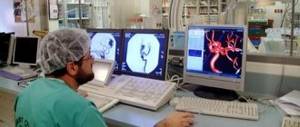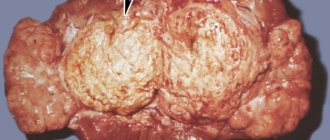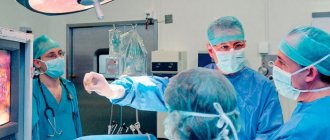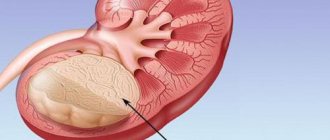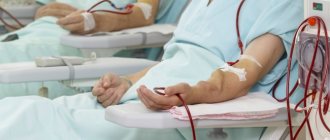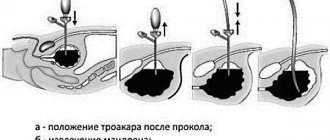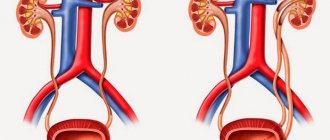If there is a malignant or benign tumor in the kidneys, the organ is removed. Nephrectomy is a surgical intervention to remove an entire organ or part of it; the intervention is performed exclusively under anesthesia. During the operation, adipose tissue, adrenal gland, and regional lymph node fractions are affected. Removing a kidney allows people to live a normal and fulfilling life, subject to certain recommendations and a healthy lifestyle. In this article we will tell you why kidney nephrectomy is performed, and also analyze the preparation and indications for the operation.
When is it required?
Indications for surgery are:
- cancer and other malignant tumors of large size that do not allow resection;
- serious open and closed injuries;
- polycystic disease occurring against the background of renal failure;
- severe urolithiasis with tissue necrosis and purulent complications;
- Wilms tumor (nephroblastoma);
- decrease in kidney function by more than 20% due to hydronephrosis;
- inflammation and diseases leading to the appearance of a secondary wrinkled kidney.
Surgical removal (nephrectomy) of the right or left kidney is one of the simplest, safest and most effective ways to treat these diseases.
Stages of implementation
Before the actual operation, a consultation is carried out with several specialists - a therapist, an anesthesiologist, and a urologist. At the same time, patients are given a number of recommendations that must be strictly adhered to.
At this stage, you should inform specialists about existing allergic reactions to medications and food, provide a complete medical history (list of previous diseases and operations), and talk about the medications you are taking. It is especially important to mention taking blood thinners to avoid serious bleeding and other complications.
A few days before the procedure, an ultrasound examination of the urinary system is performed, a series of tests are taken, and an electrocardiogram is taken. On the day of surgery, it is recommended to observe complete fasting, stop drinking any liquids 2-3 hours before, not smoke or reduce the number of cigarettes as much as possible. Failure to follow these recommendations may negatively affect the effectiveness of anesthesia and the procedure as a whole.
Nephrectomy itself is usually carried out in several stages:
- preparation – broad-spectrum antibacterial drugs are administered to prevent infectious complications;
- gaining access to the diseased organ. Laparoscopic nephrectomy is performed through 3-4 small (up to 1 cm) punctures on the abdominal wall. They are needed to insert the necessary surgical instruments and a laparoscope - a special camera that allows you to observe and control the progress of the operation. To further increase the working space, carbon dioxide is injected into the cavity through the holes to create pneumoperitoneum;
- the main stage - the surgeon dissects the tissue, moves nearby organs aside, applies special clamps to the blood vessels and ureter approaching the kidney, removes fatty tissue, visible lymph nodes and the diseased organ. If the tumor is located in the upper segment, the adrenal gland may also be removed;
- completion - one of the holes is expanded, through which the kidney is removed from the abdominal cavity. The doctor removes the instruments, carefully checks for bleeding, and closes the incisions.
Depending on the complexity, the surgical intervention can last from 1.5 to 3 hours. This is influenced by a large number of factors - the patient’s age, type, severity and stage of the disease, characteristics of the blood supply to the kidney, the size of the formations, the condition of the perinephric tissue and other factors. An important feature of the procedure is that it is completely painless, since it is performed under general anesthesia, and due to its low invasiveness, its consequences do not cause severe discomfort even after the effects of the drugs wear off.
In some cases, partial nephrectomy or kidney resection is performed - removal of only part of the organ affected by the tumor or disease. Modern techniques and instruments help ensure complete restoration of organ functionality and patient recovery. Unfortunately, this method can only be used when diagnosing diseases in the early stages and fulfilling a number of other conditions.
Cancer and kidney removal
Malignant lesions of a paired organ of the genitourinary system are a diagnosis that is made quite often recently. Surgical treatment is the only possible way to achieve a positive effect.
The classification of surgical intervention for diagnosed kidney cancer is the same as for other organ lesions. Radical nephrectomy is performed only in cases where additional examinations do not reveal distant metastases. During the operation, the surgeon ligates the arteries and veins that supply the organ with blood.
After stopping the blood supply, the left or right kidney (according to indications) located around the tissues, lymph nodes and adrenal gland is removed.
Sometimes the cancer process can be detected at the initial stage. If the tumor is small and simultaneously located in the upper or lower part of the kidney, kidney resection is performed for cancer. This surgical intervention refers to organ-preserving treatment methods.
During this procedure, it is possible to preserve a large amount of kidney tissue. In other words, the organ retains the ability to continue to perform its functions of removing decay products.
Removal of a kidney tumor by resection has direct indications:
- the patient, for various reasons, has only one kidney;
- the malignant process has not metastasized to nearby organs and tissues;
- cancer has affected both halves of the organ;
- dysfunction of a kidney that is not susceptible to cancer.
Laparoscopic kidney removal is the best choice for diagnosed kidney cancer at stages T1 - T2, when the tumor has not affected nearby tissues.
Radical nephrectomy and laparoscopic method have a common goal - the removal of an oncological process that has affected a significant part of the kidney. The difference between them is the time during which recovery occurs.
Laparoscopy not only shortens the length of hospital stay, but also reduces the severity of pain accompanying the postoperative period. Among the disadvantages is the time during which the operation will take place - the surgeon will spend at least three hours.
Can kidney cancer come back after a nephrectomy?
The oncological process at its very beginning is asymptomatic. As a rule, the first two stages are discovered by chance when a person goes to the doctor with other symptoms. Medical practice confirms that complete destruction of a tumor and its cells can be achieved only if the process does not affect the protective tissue barrier.
Removing a kidney for cancer is effective if there are no cancer cells in the blood and lymph vessels. Chemotherapy can increase the chances, as well as immunotherapy, which is increasingly prescribed today to activate the body’s own defense mechanisms.
Important! Even if the cancer process is diagnosed in a timely manner and all measures are taken to prevent spread, recurrence of kidney cancer is possible regardless of the stage.
It should be remembered that the relapse rate is also determined by the location of the malignant neoplasm. Some types of cancer affect only certain tissues of the kidney, without metastasizing to others. Histological characteristics should also be taken into account. Most often, for example, a tumor that recurs is one that consists of immature cells.
Experts also associate the likelihood of re-development with the form of the disease. The most dangerous forms in terms of frequency of repetitions and occurrence of metastases are hypernephroma and adenocarcinoma of the renal pelvis. As a rule, when these diseases are identified, the doctor warns the patient that once such malignant tumors appear, they recur even if the operation is successful.
Postoperative period
The very next day, if there are no complications, the patient can get out of bed and move around independently. In this case, minor pain and nausea may be felt - this is the body’s reaction to the administered anesthesia and accompanying medications. All negative consequences, as a rule, disappear after a few days and do not require additional drug intervention.
Doctors strongly recommend:
- drink large amounts of water (up to 2 liters per day);
- reduce or completely eliminate physical activity;
- do not lift heavy objects;
- carefully monitor the general condition of the body.
If your body temperature rises, you feel dizzy, weak, your blood pressure drops, and you experience severe acute pain in your abdomen, you should immediately consult a specialist.
For 5 years after the operation, regular examinations and examinations are carried out by a urologist, including urine and blood tests, computed tomography and other studies. If there is no recurrence of the tumor or other diseases, the patient is removed from the register.
Contraindications
Laparoscopic nephrectomy of the kidney on the right or left is not performed if:
- late stages of pregnancy;
- infectious diseases;
- acute glaucoma;
- disorders of the cardiovascular system, especially low blood clotting;
- acute inflammatory processes;
- chronic diseases at the stage of decompensation.
Some time ago, this list included a significantly larger number of contraindications - for example, the presence of scars in the abdominal area, extreme obesity. But medicine is constantly evolving, a huge number of new tools and effective techniques are appearing, thanks to which these reasons no longer interfere with the operation.
Advantages
When considering kidney surgery, the boundaries between urology and general surgery are blurred. Doctors perform donor nephrectomies for transplantation, as well as in traumatic conditions. Overall, laparoscopy for renal ectomy is a minimally invasive method that provides patients with less discomfort and equivalent results compared to the larger incision required for traditional open surgery. In contrast to classical surgical intervention, the size of tissue dissection was reduced, the wound surface was reduced, and the damaged organ was exposed. Laparoscopic nephrectomy led to less severe pain after surgery, and the patient's stay in the hospital was correspondingly reduced. After minimally invasive intervention, people returned to a normal lifestyle and work earlier, and there was a more favorable cosmetic effect. The rates of relapses and complications were identical to the results of classical surgery.
Possible complications
Despite all the advantages of laparoscopic surgery, it is still a surgical procedure that can lead to various complications. However, their number, likelihood of occurrence and severity are significantly lower than with classic open procedures.
The main complications include:
- bleeding - with almost all laparoscopy, blood loss is only 100 ml or even less. Less than 2% of patients undergoing surgery require a blood transfusion;
- postoperative hernia - extremely rare due to the small size of the incisions and the operating cavity;
- damage to neighboring tissues and organs - an enlarged surgical field, the professionalism of experienced surgeons and advanced medical technologies practically eliminate the likelihood of such an event;
- infection is a classic complication of any surgical intervention on the body. To combat it, all patients receive modern antibacterial drugs in the pre- and postoperative period.
In extremely rare cases, conversion occurs - a transition from laparoscopy to open surgery due to the technical impossibility, for various reasons, of gaining access to the organ affected by the disease.
Features of nephrectomy in our clinic
The urology department of our clinic has extensive experience in treating tumors of the prostate, bladder, and kidneys. Every day we carry out at least 2-3 relevant operations. We give preference to the minimally invasive laparoscopic or robotic type of procedures, as they have many advantages over open ones:
- less or no blood loss;
- short recovery time - the very next day the patient can move independently, and after 6-7 days - lead a full life without restrictions;
- no scars – small holes heal completely, with virtually no visible marks;
- greater control over the operation - the surgeon controls the process by watching the actions on the big screen. The image transmitted from the laparoscope has a high resolution and allows you to obtain an enlarged working field. This makes it possible to perform work more accurately.
The use of such an advanced diagnostic method as 3D modeling in our clinic allows us to carry out any operations with maximum accuracy, planning every step and movement in advance, eliminating the possibility of unforeseen situations.
You can learn more about the procedure and consult with a specialist by phone.
Laparoscopy
- The patient lies on his back, the body is fixed with bandages to avoid reflex movement. After which the patient is placed under general anesthesia.
- The peritoneal cavity is filled with gas, and the first incision is made near the umbilical cord, through which a camera is inserted for subsequent imaging.
- Next, the operation takes place according to an open (band) scheme, the only difference is that control over what is happening is carried out through the monitor, and manipulations are performed with electric scissors and a laparoscope.
This method of nephrectomy is much more gentle, but requires more professional training of medical personnel.
Complications
Consequences in the form of complications after nephrectomy occur in only 2% of patients. They most often manifest themselves in a nonspecific way:
- heart attack condition;
- thrombocytosis and thrombophlebitis;
- bleeding;
- hematoma or hernia at the incision site;
- stroke (brain circulatory failure);
- Pancreatitis is an inflammatory reaction of the pancreas.
Disturbances in the functioning of the gastrointestinal tract may also occur: constipation, gas formation, bloating.


